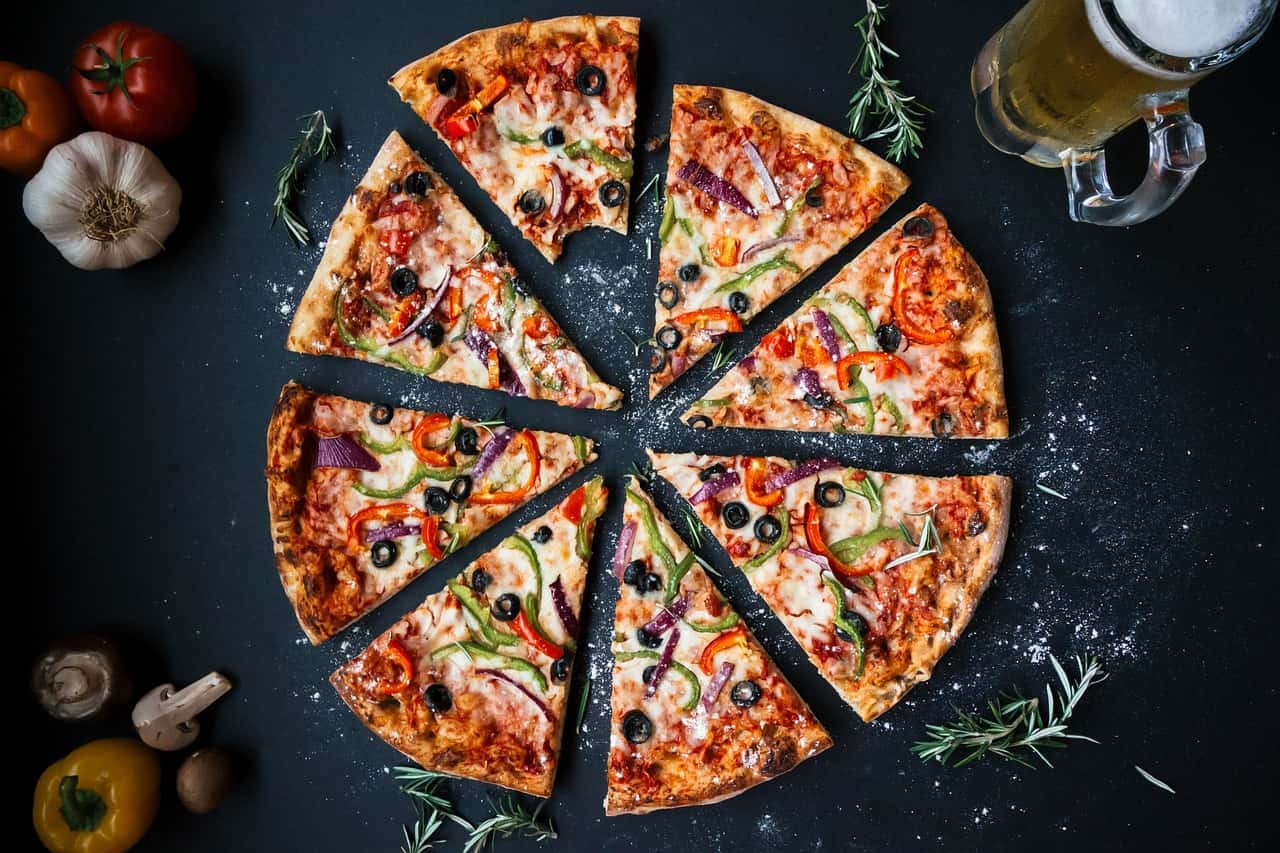
Have you ever wondered why certain foods have an irresistible hold on our taste buds? What is it about that slice of chocolate cake or those crunchy potato chips that keep us coming back for more?
While each person has their go-to comfort food, that’s not what “food addiction” refers to. In fact, food addiction is quite a thorny topic among scientists, as you shall see.
Nevertheless, there are certain foods that have garnered a reputation for their undeniable hold on our senses. One study from the University of Michigan actually did the research and ranked the most addictive foods, but also the least addictive ones.
The most addictive foods. Who can resist chocolate and pizza?
Researchers interviewed hundreds of people based on the Yale Food Addiction Scale. The Yale Food Addiction Scale (YFAS) is a widely recognized tool used to assess the presence and severity of addictive-like behaviors related to food.
Developed by Dr. Ashley N. Gearhardt and her colleagues at Yale University, the scale is designed to measure the extent to which individuals experience symptoms of food addiction. It consists of over two dozen questions meant to assess the severity of addictive eating behavior.
For instance, the researchers asked participants to count the number of times they’ve agreed with sentences like, “I eat to the point where I feel physically ill” or “I spend a lot of time feeling sluggish or fatigued from overeating.”
The researchers conducted two separate studies. In the first study, the authors interviewed 120 undergraduates who were recruited from flyers on campus or through the University of Michigan Introductory Psychology Subject Pool. Students received either financial compensation or study credit for their time.
The second study was conducted online and involved nearly 400 participants recruited using Amazon’s Mechanical Turk (MTurk) worker pool.

According to the first study, chocolate is the most addictive food. Over one in four people have an addiction-like relationship with chocolate. Ice cream, french fries, and pizza completed the list, which wasn’t at all surprising.
But there were also some surprises: breakfast cereals were more addictive than soda or fried chicken. Water was considered to be more problematic than cucumbers or beans.
| Rank | Food | Frequency | Processed? |
|---|---|---|---|
| 1 | Chocolate | 27.60 | Y |
| 2 | Ice Cream | 27.02 | Y |
| 3 | French Fries | 26.94 | Y |
| 4 | Pizza | 26.73 | Y |
| 5 | Cookie | 26.72 | Y |
| 6 | Chips | 25.38 | Y |
| 7 | Cake | 24.84 | Y |
| 8 | Popcorn (Buttered) | 23.39 | Y |
| 9 | Cheeseburger | 21.26 | Y |
| 10 | Muffin | 20.81 | Y |
| 11 | Breakfast Cereal | 20.61 | Y |
| 12 | Gummy Candy | 20.58 | Y |
| 13 | Fried Chicken | 20.18 | Y |
| 14 | Soda (Not Diet) | 20.07 | Y |
| 15 | Rolls (Plain) | 20.01 | Y |
| 16 | Cheese | 19.36 | N |
| 17 | Pretzels | 19.20 | Y |
| 18 | Bacon | 18.05 | N |
| 19 | Crackers (Plain) | 16.88 | Y |
| 20 | Nuts | 16.43 | N |
| 21 | Steak | 16.16 | N |
| 22 | Granola Bar | 14.39 | Y |
| 23 | Eggs | 13.93 | N |
| 24 | Chicken Breast | 12.61 | N |
| 25 | Strawberries | 12.42 | N |
| 26 | Apple | 10.21 | N |
| 27 | Corn (No Butter or Salt) | 9.92 | N |
| 28 | Salmon | 9.44 | N |
| 29 | Banana | 9.34 | N |
| 30 | Carrots (Plain) | 9.08 | N |
| 31 | Brown Rice (Plain, No Sauce) | 8.79 | N |
| 32 | Water | 6.91 | N |
| 33 | Cucumber (No Dip) | 6.83 | N |
| 34 | Broccoli | 6.48 | N |
| 35 | Beans (No Sauce) | 6.47 | N |
“As hypothesized, highly processed foods (with added fat and/or refined carbohydrates) appeared to be most associated with behavioral indicators of addictive-like eating,” the study writes.
For the second study, the top rankings were reversed. The most addictive food was pizza, with chocolate settling for second. Chips, cookies, and ice cream come closely after. Breakfast cereal dropped significantly, and the least addictive food was cucumber.
| Rank | Food | Mean Rating | Processed? |
|---|---|---|---|
| 1 | Pizza | 4.01 | Y |
| 2 | Chocolate | 3.73 | Y |
| 2 | Chips | 3.73 | Y |
| 4 | Cookie | 3.71 | Y |
| 5 | Ice Cream | 3.68 | Y |
| 6 | French Fries | 3.60 | Y |
| 7 | Cheeseburger | 3.51 | Y |
| 8 | Soda (Not Diet) | 3.29 | Y |
| 9 | Cake | 3.26 | Y |
| 10 | Cheese | 3.22 | N |
| 11 | Bacon | 3.03 | N |
| 12 | Fried Chicken | 2.97 | Y |
| 13 | Rolls (Plain) | 2.73 | Y |
| 14 | Popcorn (Buttered) | 2.64 | Y |
| 15 | Breakfast Cereal | 2.59 | Y |
| 16 | Gummy Candy | 2.57 | Y |
| 17 | Steak | 2.54 | N |
| 18 | Muffin | 2.50 | Y |
| 19 | Nuts | 2.47 | N |
| 20 | Eggs | 2.18 | N |
| 21 | Chicken Breast | 2.16 | N |
| 22 | Pretzels | 2.13 | Y |
| 23 | Crackers (Plain) | 2.07 | Y |
| 24 | Water | 1.94 | N |
| 25 | Granola Bar | 1.93 | Y |
| 26 | Strawberries | 1.88 | N |
| 27 | Corn (No Butter or Salt) | 1.87 | N |
| 28 | Salmon | 1.84 | N |
| 29 | Banana | 1.77 | N |
| 30 | Broccoli | 1.74 | N |
| 30 | Brown Rice (Plain, No Sauce) | 1.74 | N |
| 32 | Apple | 1.66 | N |
| 33 | Beans (No Sauce) | 1.63 | N |
| 34 | Carrots | 1.60 | N |
| 35 | Cucumber (No Dip) | 1.53 | N |
“In summary, the current study found that highly processed foods, with added amounts of fat and/or refined carbohydrates (e.g., sugar, white flour), were most likely to be associated with behavioral indicators of addictive-like eating. Additionally, foods with high glycemic index (GL) were especially related to addictive-like eating problems for individuals endorsing elevated symptoms of food addiction.”
“Individuals endorsing symptoms of addictive-like eating behavior may be more susceptible to the large blood sugar spike of high GL foods, which is consistent with the importance of dose and rate of absorption in the addictive potential of drugs of abuse,” the study concludes.
Is food addiction a real thing?

Food addiction is quite controversial among the scientific community. At first glance, the idea of food addiction is ridiculous because we need calories and other nutrients found in food in order to survive. However, the concept of food addiction isn’t as crazy as it may sound.
Research suggests some people are more likely than others to seek out palatable foods — meaning foods high in fat and sugar that humans naturally find tasty — even when this behavior leads to negative consequences.
Addiction is traditionally associated with substances like drugs or alcohol. Addiction is characterized by compulsive behavior, loss of control, and negative consequences when you don’t have access to the object of addiction (i.e. withdrawal symptoms). It involves the brain’s reward system and neurotransmitters, particularly dopamine, which play a pivotal role in reinforcing pleasurable experiences.
There is no consensus on the definition of “food addiction” among scientists. The Diagnostic and Statistical Manual of Mental Disorders (DSM-5), the so-called “psychiatry bible” that lists all psychiatric disorders, does not mention food addiction as a condition.
But although food addiction isn’t yet formally recognized, the Yale Food Addiction Scale is based on the diagnostic criteria for substance use disorders outlined in the DSM-5, adapted to the context of food.
Some scientists have even gone as far as claiming that sugar is just as addictive as hard drugs like cocaine and opium.
“Consuming sugar produces effects similar to that of cocaine, altering mood, possibly through its ability to induce reward and pleasure, leading to the seeking out of sugar,” wrote cardiovascular research scientist James J DiNicolantonio and cardiologist James H O’Keefe, both from Saint Luke’s Mid America Heart Institute in Kansas in a review published in the British Journal of Sports Medicine.
The research cited by these scientists is all based on studies on rats. These studies found that rodents prefer sugar over cocaine, as well as evidence of sugar withdrawal.
However, these kinds of conclusions are severely flawed and are just bad science. Most animals will prefer sweet things over cocaine and the anxious behavior of rodents after eating sugar is by no means a clear indication of addiction-related withdrawal.
Other studies have found made parallels between the effects of cocaine and sugar on the brain. Indeed, both food and drugs like cocaine act upon more or less the same brain reward system. However, pharmacologically speaking the two are not the same, nor are their effects. Drugs of abuse hijack the reward system and turn off their normal controls.
Turning food cravings into a habit is not the same thing as being addicted to cocaine or heroin. I don’t think there’s a person in history that robbed a convenience store to get their sugar fix. Any sane person is aware of this.
But putting these exaggerated claims aside, there is indeed evidence that suggests sugar and processed foods have some addictive properties. Certain highly palatable foods light up the pleasure center in the brain and trigger a rush of dopamine.
In individuals who are more predisposed to addiction, these chemicals can overpower other brain signals that convey feelings of fullness or satisfaction, resulting in a cycle of overeating.
Over time, these individuals may develop a tolerance to the addictive foods, requiring larger quantities to experience the same level of pleasure. Despite recognizing the negative consequences of overeating and wanting to quit, their efforts prove ineffective. In such cases, people often use addiction-related words, such as cravings, withdrawal, and a loss of control, to describe their relationship with food.
Many times, addictive eating behaviors are sometimes used as a means to cope with stress and emotions. While further research is necessary, it is evident that many individuals experience addiction-like eating patterns, which can negatively impact their health, self-esteem, and overall quality of life.
And while food addiction isn’t as evident as abusing hard drugs, it can also kill.
According to data from the National Health and Nutrition Examination Survey, more than two in five American adults are obese, and nearly one in five children are obese. While it may not directly cause death, obesity substantially increases the likelihood of developing various life-threatening conditions, such as cardiovascular disease, type 2 diabetes, cancer, and liver disease.



